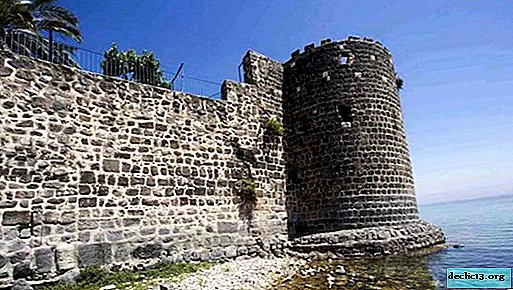Fairy-tale ruellia: growing, propagating and caring for a plant at home, as well as a photo of a flower

Ruellia (Ruellia) - a beautiful moody plant with attractive flowers of unusual shape and texture. Perennial shrubs are covered with bright "gramophone" with velvety petals.
Often this plant is called Mexican petunia, but in general in nature there are about 200 varieties.
Ruelia is a rather whimsical, but at the same time, perennial bush, which, with proper care, will certainly delight its owner with a beautiful and long flowering.
Botanical Description
The flower is named after the medieval French biologist Jean Ruelle, who first performed the scientific description of the species and classified the plant. The second name is dipteracantus (Dipterakantus). Less common due to dissonance.
At first, ruellia was considered a separate species. Subsequently, plant varieties began to be attributed to the same genus - the differences were insignificant.
Rowellia-dipteracanthus is also known as Mexican petunia. In nature, more than 200 species of this representative of the Acanthus family are known.
Plant Description:
- The natural habitat of dipteracanthus is considered to be the American tropics and subtropics, southern Asia and African forest belts.
- It is a shrub, shrub or herbaceous plant. The stems are actively branching. The shape can be creeping, granular, lodging or straight. The root system is fibrous.
- The leaves of Roullia are long, solid, dark green in color. They are matte and shiny. The shape of the leaves is invariably oblong, the color is found both mottled and uniformly monophonic. Some species of dipteracanthus have very beautiful leaves of a saturated malachite color with a velvet surface. A light streak runs along the central arrow of the leaf. The bottom surface of the leaf is a purple-wine color. Stipules absent.
- The flowers of the plant are distinguished by a wide range of colors - white with blue stripes, violet-white, raspberry, red, pink, burgundy, beige. In structure, these are large individual flowers (length about 5 cm), similar to the bell of an old gramophone. Petals bent back. They are opened at the base of the leaves on the edge of the shoot.
Flowers are odorless. Each “gramophone” blooms for only a few hours - from morning to noon. This does not really spoil the appearance of the plant, because new flowers are constantly being revealed.
- After the color falls, a gray seed box-pentagon ripens in the box. The ripened fruit bursts at the seam, scattering from 2 to 20 black seeds around for a significant distance.
- Young shrubs have straight stems, a mature plant slopes to the ground. Stalks that touch the ground are prone to rooting.
Dipteracanthus: main types and photos
Then you can read the description of the main types and varieties, as well as see photos of flowers.
Britton
Ruellia brittoniana is an evergreen perennial plant of the Acanthus family. It grows in colonies. It reaches a height of 90 cm. Near the shrub, there are upright stems of a semi-woody structure and oblong dark green leaves of an elliptical shape. In the sun they shine blue with a metallic tint. Bluish-violet tubular flowers expand at the top. The diameter of the flower is about 5 cm.
Suitable for home gardening. Florists brought up many hybrid varieties based on Britton's Rwellia:
- Katie - undersized shrub with an armful of leaves and violet-lilac flowers.
- White Katie - ruellia with bright white petals.
- Chi Chi - with a crimson pink color.

Blue
Ruellia Southern Star Blue - perennial stunted shrub reaches a height of not more than 30 cm. Climbing climbing plant. It blooms with blue and lilac buds resembling petunia flowers. The diameter of the flower is 5 cm. The leaves are of a uniform dark green color, without spots, similar to willow leaves.
Varietal variety of dipteracanthus. Ampel plant. It withstands freezing up to -12⁰С. It tolerates exposure to high temperatures and low humidity. It is grown as a houseplant or groundcover.

Devo or Devos
Ruellia devosianus is a species of dipteracanthus native to the humid tropics of Brazil. A herbaceous evergreen. A branched stem with a silvery velvety surface reaches 40 cm in height. The leaves are small, pubescent, on top - rich emerald, on the bottom - maroon. With bright arrows. It blooms with white or lavender five-petalled axillary corollas with a purple or lilac vein. Abundant flowering in the autumn-winter period.
The plant looks spectacular during the growing season - due to the unusual coloring of the leaves.

Karolinskaya
Ruellia caroliniensis is a herbaceous perennial up to 1.5 m high. Throws creeping semi-ampel stems up to half a meter long. The green part of the plant is covered with thick cannon hairs. The leaves are ordinary, green in color. Pronounced greenish veins. Tubular five-petalled flowers of lilac color, the limbs of the petals are purple, the corollas are small - up to 2.5 cm in diameter.
Loves plentiful watering. Carries direct sunlight. It can grow on sparse sandy soil with good drainage. Seed germination is low. Propagation by cuttings.Shade-tolerant and the most unpretentious variety of Mexican petunia.

Portella
Ruellia Portellae is an herbaceous perennial tropical species. The height of the stem is from 30 to 45 cm. The descending ampelous shoots take root upon contact with the soil. Ovate large leaves of a saturated brownish-green color, the lower surface is reddish brown. Covered with a light pattern. Large bright pink or raspberry cone-shaped flowers. It features long flowering, usually in late summer.
In the conditions of a home or homestead farm, Roellia Portella is an annual plant that requires annual renewal.

Planting and reproduction at home
Planting Roullia is better to plan for the spring. Optimal to do this in March.
Soil preparation
You will need a light, loose (water- and breathable) nutrient soil with drainage (peat or sand mixture):
- sod (1 part);
- leaf soil (1 part);
- peat soil (1/2 part);
- fine gravel (1/2 part).
A universal soil mixture like TerraVita is also suitable, supplemented with a small amount of vermiculite or perlite (per 1 pot). It’s great if you can enrich the soil with biohumus - liquid or loose. Acidity - neutral or slightly acidic.
Methods
Seed
The advantage of this method of planting Roullia is that the process of propagation by seeds often takes place in a natural way - seeds ripened in boxes fall on the soil in a pot and germinate. The seeds of Roullia are characterized by high germination.
The disadvantage of this method is that the process takes longer, compared with propagation by cuttings, and is not always controlled.
Seed preparation:
- Seeds are collected manually - the box is slightly flattened, after which the fruit is opened.
- Land immediately, without prior preparation. Additional stratification is not required.
Seed Planting Sequence:
 A sand-peat soil mixture is prepared.
A sand-peat soil mixture is prepared.- Wide containers are filled with substrate.
- Prepared seeds are sown in soil to a depth of 1 cm.
- Seeds are slightly covered with soil, without deepening.
- The substrate is abundantly moistened from the spray gun.
- The surface of the tray is covered with a film.
- Pots are placed in a ventilated, non-illuminated greenhouse (maintained at a temperature of 20-25 ° C).
- The emerged sprouts are planted in a heap in a common pot (5-7 seedlings).
- Pots with young plants are placed on the illuminated windowsill.
- After the appearance of a pair of real leaves, the sprouts dive into separate containers.
Cuttings
Advantages of the method: thus, Ruell can be propagated faster than when sowing seeds.
Disadvantages of the method: additional preparation of cuttings is required, and only certain processes are suitable.
Preparation of cuttings:
- Vegetative propagation of ruellia is made in the spring.
- For planting, young apical cuttings 5-8 cm long are best suited. There must be at least two nodes on the surface of each stem.
- To stimulate root formation, cuttings are kept for 24 hours in a root solution. You can replace epin or heteroauxin.
The soil is prepared the same as for planting seeds. Some gardeners grow cuttings on peat tablets. It is important to moisten the substrate sparingly - due to excessive moisture, the seedlings can rot.
The process of propagation of ruellia by cuttings:
- Apical young cuttings are separated.
- For a day, the stems are placed in a root solution.
- Large leaves are shortened by 1/3.
- Seedlings are planted in prepared soil.
- The substrate in the trays is moistened (moderately).
- The surface of containers with seedlings is insulated with a film.
- The tops are pinched (for the appearance of lateral processes).
- Trays with plants are placed in a greenhouse for rooting (at a temperature of 21 ° C).
- Rooting of cuttings is expected.
- After soil development in containers, young plants are planted in small groups in separate pots.
 In summer and spring, non-lignified cuttings are well rooted in water.
In summer and spring, non-lignified cuttings are well rooted in water.
Use transparent plastic trays for propagation by cuttings - so you will quickly notice the roots and the degree of growth.
If the ruellia has grown greatly, it is permissible to divide the shrub into separate young plants and plant it in different pots. The substrate in the tanks is subject to renewal.
Ruelia pleasant is well propagated by cuttings - annual renewal will allow you to enjoy young densely flowering shrubs.
Layering
Dipteracanthus can be propagated by layering:
- The stem bends to the surface of the earth and is fixed in such a way that the nodes on the shoots are in contact with the ground.
- After rooting, the cuttings are separated and transplanted.
Outdoor cultivation
Unpretentious and hardy varieties of wild petunia are suitable for the garden:
- Roullium of Drummond;
- ruellia holoflower;
- squared ruellia.
Flower care
- A flower pot is best placed on a west or east window. Sunlight should be sufficient, but bright rays should not directly hit the plant. In low light conditions (on the north side of the room) the shoots will be unnecessarily long, the ruellium will not bloom. However, such conditions contribute to the formation of a beautiful leaf color - saturated and contrasting.
- In winter and in dark rooms, dipteracanthus needs artificial lighting.
- On the southern windows, the plant should be protected from direct sunlight. Cover the delicate ruellia from the scorching sun with a curtain.
- Avoid drafts - the plant can drop the lower tier of foliage.
- In summer, the optimum room temperature is 25⁰С. In winter - at least 18⁰С. Do not place ruellium on cold stone window sills - the plant will drop the lower layer of leaves.
- The flower needs regular uniform watering in the summer. The soil should not dry out. Pouring is also not necessary. It is desirable to water it with settled soft water.
- The air in the apartment must be humid. Use a spray bottle, place a humidifier near it, or place a pot of Ruellium in a deep container with wet expanded clay or peat.
- A moisture-loving plant does not tolerate neighborhood with heating appliances - this is fraught with dry and wrinkled leaves. When spraying, the Ruellia throws new shoots and leaves.
- Nailing is carried out periodically for several months - from March to July. Do not pinch the plant since the end of summer - this will slow down the formation of buds.
- It is better to feed the plant in the phase of active growth - in the warm season, starting in spring. This is the time of the active appearance of the buds. They nourish the soil with special fertilizers for flowering plants. When transplanting, multifunctional fertilizers are laid in fresh soil. Rowell is not fed in the cold winter months.
You can’t smoke near ruellia. The plant does not tolerate smoke, so the kitchen is also not the best place.
The plant needs watering only in the dry season. Ruelia is thermophilic, often grown as a summer plant.
How to prepare a plant for winter?
 Since Roullia hails from the tropics, wintering in open ground in the middle lane is not always possible. The ground part of the bush dies if the temperature drops below zero. When comfortable conditions are restored, Ruellia grows again.
Since Roullia hails from the tropics, wintering in open ground in the middle lane is not always possible. The ground part of the bush dies if the temperature drops below zero. When comfortable conditions are restored, Ruellia grows again.
Roullia Southern Star is positioned as a perennial that does not winter in the open at all. However, the indicated frost resistance threshold is minus 12 ° C.
In winter, it is advisable to transfer pots with ruellium for wintering to a cool room (18 ° C) and water abundantly, keep away from heaters and drafts. To do this, shrubs are dug up and transplanted into wide containers. If this is not possible, the sites with Ruellia must be covered with polyethylene for the winter.
Outdoor conditions
- Shine. The plant prefers well-lit areas, but quite tolerably feels in a shallow shadow. In these conditions, the ruellium will bloom less frequently, throwing out smaller corollas. Variegated dipteracanthus can not be planted in areas with open sunlight. Varieties with plain leaves willingly grow on the south side of the site.
Reference! With insufficient lighting, the plant throws long sloppy stems. Some varieties can not stand the bright color: stains from burns appear on the leaves, the color changes. Learn the features of each variety.
- The soil. The soil is good dry or slightly moist. Drainage or light air and permeable soil are required. If the soil is oversaturated with moisture and nutrients, the plant will grow rapidly and unpredictably.
- Temperature and humidity. Ruelia is sensitive to changes in temperature and soil moisture. In cool conditions, growth and flowering are suspended. The optimum temperature for plentiful lush flowering and freshness of greenery is above 20 ° C. The culture is hygrophilous.
- Seating. To preserve the accuracy and downsizing of plant groups, the ruellium often needs to be planted.
- Pinching bushes will provide splendor of forms.
Diseases and Pests
With proper care, under suitable conditions, Ruellia is not prone to infections. The main danger is insects (aphids, whiteflies, scale insects, ticks, insects). Insects infect weakened plants.
- The spider mite appears due to violations of the conditions of care. How to get rid of an intruder:
- Treat the foliage with a soapy solution.
- After keeping the composition, wash the leaves. Soap film will block oxygen by the insect.
- After rinsing gently, cover the roof with a bag or take it to the greenhouse.The tick does not tolerate high humidity.
- In the summer, whitefly attacks Rwellia. Of the insecticides, Actellik or Fitoverm are acceptable.
For disease prevention, follow the care recommendations. Despite the fact that the plant is rather capricious, ruellia is a real decoration of an apartment or a personal plot. Following the recommendations for care, it is not difficult to tame a tropical beauty.

 A sand-peat soil mixture is prepared.
A sand-peat soil mixture is prepared.















